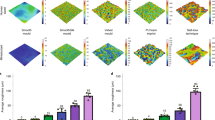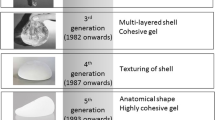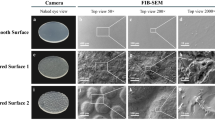Abstract
Several companies offer anatomically shaped breast implants but differences among manufacturers are often misunderstood. The shell texture is a crucial parameter for anatomically shaped implants to prevent rotation and to decrease the risk of capsular contracture, even though concerns have recently been raised concerning the complications associated with textured breast implants. The aim of this study was to characterize differences in terms of texture, cell adhesion, shape, and stiffness between some commonly used anatomically shaped implants from three different manufacturers.
Methods
Five commercially available anatomically shaped breast implants from 3 different manufacturers (Allergan, Mentor, and Sebbin) were used. Scanning electron microscopy, X-ray microtomography, and scanning mechanical microscopy were used to characterize the shell texture. Human fibroblast adhesion onto the shells was evaluated. 3D models of the implants were obtained using CT-scan acquisitions to analyze their shape. Implant stiffness was evaluated using a tractiometer.
Results
Major differences were observed in the topography of the textures of the shells, but this was not conveyed by a statistically significant fibroblast adhesion difference. However, fibroblasts adhered better on anatomically shaped textured implants than on smooth implants (p < 0.01). Our work pointed out differences in the Biocell® texture in comparison with older studies. The 3D analysis showed significant shape differences between the anatomically shaped implants of the 3 companies, despite similar dimensions. Implant stiffness was comparable among the 3 brands.
Conclusions
Each texture had its specific topography, and this work is the first description of Sebbin anatomic breast implant texturation. Moreover, major discrepancies were found in the analysis of the Biocell® texture when comparing our results with previous reports. These differences may have clinical implications and are discussed. This study also highlighted major shape differences among breast implants from different manufacturers, which is quite counterintuitive. The clinical impact of these differences however needs further investigation.
No Level Assigned
This journal requires that authors assign a level of evidence to each submission to which Evidence-Based Medicine rankings are applicable. This excludes Review Articles, Book Reviews, and manuscripts that concern Basic Science, Animal Studies, Cadaver Studies, and Experimental Studies. For a full description of these Evidence-Based Medicine ratings, please refer to the Table of Contents or the online Instructions to Authors www.springer.com/00266.









Similar content being viewed by others
References
Brown MH, Shenker R, Silver SA (2005) Cohesive silicone gel breast implants in aesthetic and reconstructive breast surgery. Plast Reconstr Surg 116(3):768–779
Barnsley GP, Sigurdson LJ, Barnsley SE (2006) Textured surface breast implants in the prevention of capsular contracture among breast augmentation patients: a meta-analysis of randomized controlled trials. Plast Reconstr Surg 117(7):2182–2190
Niechajev I, Jurell G, Lohjelm L (2007) Prospective study comparing two brands of cohesive gel breast implants with anatomic shape: 5-year follow-up evaluation. Aesthetic Plast Surg 31(6):697–710
Poeppl N, Schreml S, Lichtenegger F, Lenich A, Eisenmann-Klein M, Prantl L (2007) Does the surface structure of implants have an impact on the formation of a capsular contracture? Aesthetic Plast Surg 31(2):133–139
Hall-Findlay EJ (2011) Breast implant complication review: double capsules and late seromas. Plast Reconstr Surg 127(1):56–66
Mazzocchi M, Dessy LA, Carlesimo B, Marchetti F, Scuderi N (2010) Late seroma formation after breast surgery with textured silicone implants: a problem worth bearing in mind. Plast Reconstr Surg 125(4):176e–177e
Colville RJI, McLean NR, Cross PA (2003) Double capsule or capsule within a capsule: is there a difference? Br J Plast Surg 56(7):724
Brody GS, Deapen D, Taylor CR, Pinter-Brown L, House-Lightner SR, Andersen JS et al (2015) Anaplastic large cell lymphoma occurring in women with breast implants: analysis of 173 cases. Plast Reconstr Surg 135(3):695–705
Mazzocchi M, Dessy LA, Corrias F, Scuderi N (2012) A clinical study of late seroma in breast implantation surgery. Aesthetic Plast Surg 36(1):97–104
Santanelli di Pompeo F, Laporta R, Sorotos M, Di Napoli A, Giovagnoli MR, Cox MC et al (2015) Breast implant-associated anaplastic large cell lymphoma: proposal for a monitoring protocol. Plast Reconstr Surg 136(2):144e–151e
Héden P (2011) Breast augmentation with anatomic, high-cohesiveness silicone gel implants (European Experience). In: Spear S (ed) Surgery of the Breast: Principles and Art, 3rd edn. Wolters Kluwer/Lippincott Williams & Wilkins, Philadelphia, pp 1322–1345
Tebbetts JB, Adams WP (2006) Five critical decisions in breast augmentation using five measurements in 5 minutes: the high five decision support process. Plast Reconstr Surg 118(Supplement):35S–45S
Tebbetts JB (2002) A system for breast implant selection based on patient tissue characteristics and implant-soft tissue dynamics. Plast Reconstr Surg 109(4):1396–1409 discussion 1410–5
Hidalgo DA (2000) Breast augmentation: choosing the optimal incision, implant, and pocket plane. Plast Reconstr Surg. 105(6):2202–2216discussion 2217–8
Heimann T, Meinzer H-P (2009) Statistical shape models for 3D medical image segmentation: a review. Med Image Anal 13(4):543–563
Yushkevich PA, Piven J, Hazlett HC, Smith RG, Ho S, Gee JC et al (2006) User-guided 3D active contour segmentation of anatomical structures: significantly improved efficiency and reliability. NeuroImage. 31(3):1116–1128
Kinney BM, Jeffers LLC, Ratliff GE, Carlisle DA (2014) Silicone gel breast implants: science and testing. Plast Reconstr Surg 134:47S–56S
Paek LS, Tétreault-Paquin JO, St-Jacques S, Nelea M, Danino MA (2013) Le microscope électronique à balayage environnemental est-il un outil pertinent pour l’analyse des capsules périprothétiques mammaires ? Ann Chir Plast Esthét. 58(3):201–207
Barr S, Hill E, Bayat A (2009) Current implant surface technology: an examination of their nanostructure and their influence on fibroblast alignment and biocompatibility. Eplasty. 9:e22
Danino AM, Basmacioglu P, Saito S, Rocher F, Blanchet-Bardon C, Revol M et al (2001) Comparison of the capsular response to the Biocell RTV and Mentor 1600 Siltex breast implant surface texturing: a scanning electron microscopic study. Plast Reconstr Surg 108(7):2047–2052
Danino A, Rocher F, Blanchet-Bardon C, Revol M, Servant JM (2001) A scanning electron microscopy study of the surface of porous-textured breast implants and their capsules. Description of the “velcro” effect of porous-textured breast prostheses. Ann Chir Plast Esthét. 46(1):23–30
Giot J-P, Paek LS, Nizard N, El-Diwany M, Gaboury LA, Nelea M et al (2015) The double capsules in macro-textured breast implants. Biomaterials 23(67):65–72
Hedén P, Jernbeck J, Hober M (2001) Breast augmentation with anatomical cohesive gel implants: the world’s largest current experience. Clin Plast Surg 28(3):531–552
Hedén P, Boné B, Murphy DK, Slicton A, Walker PS (2006) Style 410 cohesive silicone breast implants: safety and effectiveness at 5 to 9 years after implantation. Plast Reconstr Surg 118(6):1281–1287
Bobyn JD, Wilson GJ, MacGregor DC, Pilliar RM, Weatherly GC (1982) Effect of pore size on the peel strength of attachment of fibrous tissue to porous-surfaced implants. J Biomed Mater Res 16(5):571–584
Valencia-Lazcano AA, Alonso-Rasgado T, Bayat A (2013) Characterisation of breast implant surfaces and correlation with fibroblast adhesion. J Mech Behav Biomed Mater 21:133–148
Maxwell GP, Gabriel A (2014) The Evolution of Breast Implants: Plast Reconstr Surg. 134:12S–17S
Brohim RM, Foresman PA, Hildebrandt PK, Rodeheaver GT (1992) Early tissue reaction to textured breast implant surfaces. Ann Plast Surg 28(4):354–362
Abramo AC, De Oliveira VR, Ledo-Silva MC, De Oliveira EL (2010) How texture-inducing contraction vectors affect the fibrous capsule shrinkage around breasts implants? Aesthetic Plast Surg 34(5):555–560
Hammond DC, Migliori MM, Caplin DA, Garcia ME, Phillips CA (2012) Mentor Contour Profile Gel Implants: clinical Outcomes at 6 Years. Plast Reconstr Surg 129(6):1381–1391
Maxwell GP, Scheflan M, Spear S, Nava MB, Hedén P (2014) Benefits and limitations of macrotextured breast implants and consensus recommendations for optimizing their effectiveness. Aesthetic Surg J Am Soc Aesthetic Plast Surg. 34(6):876–881
Derby BM, Codner MA (2015) Textured silicone breast implant use in primary augmentation: core data update and review. Plast Reconstr Surg 135(1):113–124
Sampaio Góes JC (2010) Breast implant stability in the subfascial plane and the new shaped silicone gel breast implants. Aesthetic Plast Surg 34(1):23–28
Maxwell GP, Van Natta BW, Murphy DK, Slicton A, Bengtson BP (2012) Natrelle style 410 form-stable silicone breast implants: core study results at 6 years. Aesthetic Surg J Am Soc Aesthetic Plast Surg. 32(6):709–717
Góes JCS, Landecker A (2003) Optimizing outcomes in breast augmentation: seven years of experience with the subfascial plane. Aesthetic Plast Surg 27(3):178–184
Macadam SA, Clugston PA, Germann ET (2004) Retrospective case review of capsular contracture after two-stage breast reconstruction: is colonization of the tissue expander pocket associated with subsequent implant capsular contracture? Ann Plast Surg 53(5):420–424
Liu X, Zhou L, Pan F, Gao Y, Yuan X, Fan D (2015) Comparison of the postoperative incidence rate of capsular contracture among different breast implants: a cumulative meta-analysis. PLoS One 10(2):e0116071
Wiener TC (2008) Relationship of incision choice to capsular contracture. Aesthetic Plast Surg 32(2):303–306
Jacobson JM, Gatti ME, Schaffner AD, Hill LM, Spear SL (2012) Effect of incision choice on outcomes in primary breast augmentation. Aesthetic Surg J Am Soc Aesthetic Plast Surg. 32(4):456–462
Ben Amar M, Wu M, Trejo M, Atlan M (2015) Morpho-elasticity of inflammatory fibrosis: the case of capsular contracture. J R Soc Interface R Soc. 201:12
Calobrace MB, Capizzi PJ (2014) The Biology and Evolution of Cohesive Gel and Shaped Implants. Plast Reconstr Surg. 134:6S–11S
Nipshagen MD, Beekman WH, Esmé DL, de Becker J (2007) Anatomically shaped breast prosthesis in vivo: a change of dimension? Aesthetic Plast Surg 31(5):540–543
Tebbetts JB (2000) Patient acceptance of adequately filled breast implants using the tilt test. Plast Reconstr Surg 106(1):139–147 discussion 148–9
Acknowledgments
Per Hedén is a regular consultant for ALLERGAN for breast and face. None of the authors has a financial interest in any of the products, devices, or drugs mentioned in this manuscript.
Author information
Authors and Affiliations
Corresponding author
Rights and permissions
About this article
Cite this article
Atlan, M., Bigerelle, M., Larreta-garde, V. et al. Characterization of Breast Implant Surfaces, Shapes, and Biomechanics: A Comparison of High Cohesive Anatomically Shaped Textured Silicone, Breast Implants from Three Different Manufacturers. Aesth Plast Surg 40, 89–97 (2016). https://doi.org/10.1007/s00266-015-0603-8
Received:
Accepted:
Published:
Issue Date:
DOI: https://doi.org/10.1007/s00266-015-0603-8




